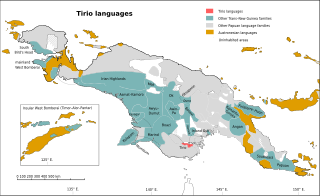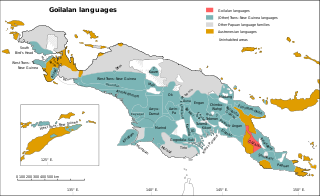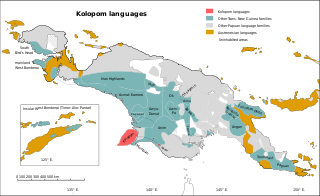Related Research Articles

The Kiwaian languages form a language family of New Guinea. They are a dialect cluster of half a dozen closely related languages. They are grammatically divergent from the Trans–New Guinea languages, and typically have singular, dual, trial, and plural pronouns.

The Mek languages are a well established family of Papuan languages spoken by the Mek peoples. They form a branch of the Trans–New Guinea languages (TNG) in the classifications of Stephen Wurm (1975) and of Malcolm Ross (2005).
The Paniai Lakes languages, also known as the Wissel Lakes or Wissel Lakes – Kemandoga River, are a small family of closely related Trans–New Guinea languages spoken in the Paniai Lakes region of the highlands of Western New Guinea in the Paniai Lakes region of Papua. Foley (2003) considers their Trans–New Guinea status to be established.
The Kutubuan languages are a small family of neighboring languages families in Papua New Guinea. They are named after Lake Kutubu in Papua New Guinea.

The Duna–Pogaya (Duna–Bogaia) languages are a proposed small family of Trans–New Guinea languages in the classification of Voorhoeve (1975), Ross (2005) and Usher (2018), consisting of two languages, Duna and Bogaya, which in turn form a branch of the larger Trans–New Guinea family. Glottolog, which is based largely on Usher, however finds the connections between the two languages to be tenuous, and the connection to TNG unconvincing.

The Tirio languages are a family of Trans–New Guinea languages in the classification of Malcolm Ross. The Tirio languages have about 40% of their lexicon in common.

The Chimbu–Wahgi languages are a language family sometimes included in the Trans–New Guinea proposal.

The East Strickland or Strickland River languages are a family of Papuan languages.
The Dagan or Meneao Range languages are a small family of Trans–New Guinea languages spoken in the Meneao Range of the "Bird's Tail" of New Guinea, the easternmost Papuan languages on the mainland. They are the most divergent of the several small families within the Southeast Papuan branch of Trans–New Guinea.
The Yareban or Musa River languages are a small family of Trans–New Guinea languages spoken near the Musa River in the "Bird's Tail" of New Guinea. They are classified within the Southeast Papuan branch of Trans–New Guinea.
The Manubaran languages are a small family of Trans–New Guinea languages spoken around Mount Brown in the "Bird's Tail" of New Guinea. They are classified within the Southeast Papuan branch of Trans–New Guinea.
The Koiarian languages Koiari are a small family of Trans–New Guinea languages spoken in the "Bird's Tail" of New Guinea. They are classified within the Southeast Papuan branch of Trans–New Guinea.

The Goilalan or Wharton Range languages are a language family spoken around the Wharton Range in the "Bird's Tail" of New Guinea. They were classified as a branch of the Trans–New Guinea languages by Stephen Wurm (1975), but only tentatively retained there in the classification of Malcolm Ross (2005) and removed entirely by Timothy Usher (2020).
Sobei is one of the Sarmi languages spoken in three villages near the district center of Sarmi in Papua province of Indonesia. Ethnologue (2005) cites two third-party population estimates of 1,000 and 1,850, while Sterner estimates the population at 1,500 (1975) and 2,000 (1987), based on actual residence in the area.

The Kolopom languages are a family of Trans–New Guinea languages in the classifications of Stephen Wurm (1975) and of Malcolm Ross (2005). Along with the Mombum languages, they are the languages spoken on Yos Sudarso Island.

The Manobo languages are a group of languages spoken in the Philippines. Their speakers are primarily located around Northern Mindanao, Central Mindanao and Caraga regions where they are natively spoken. Some outlying groups make Manobo geographically discontiguous as other speakers can be located as far as the southern peninsula of Davao Oriental, most of Davao Occidental and coastal areas of Sultan Kudarat. The Kagayanen speakers are the most extremely remote and can be found in certain portions of Palawan.
The Greater Central Philippine languages are a proposed subgroup of the Austronesian language family. They are spoken in the central and southern parts of the Philippines, and in northern Sulawesi. This subgroup was first proposed by Robert Blust (1991) based on lexical and phonological evidence, and is accepted by most specialists in the field.

Wiru or Witu is the language spoken by the Wiru people of Ialibu-Pangia District of the Southern Highlands Province of Papua New Guinea.
Etyma is a genus of longhorn beetles of the subfamily Lamiinae, containing the following species:
Etyma curu is a species of beetle in the family Cerambycidae. It was described by Galileo and Martins in 2012.
References
- ↑ BioLib.cz - Etyma icima. Retrieved on 8 September 2014.